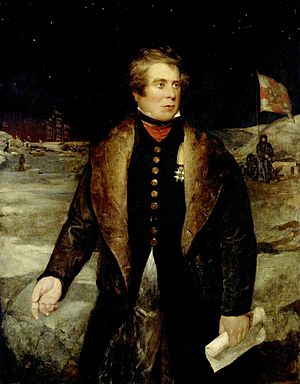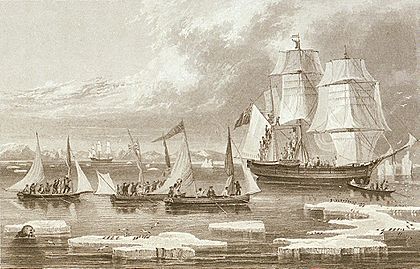John Ross (Royal Navy officer) facts for kids
Quick facts for kids
Sir
John Ross
|
|
|---|---|
 |
|
| British Consul at Stockholm | |
| In office 8 March 1839 – 10 February 1846 |
|
| Preceded by | George Foy |
| Succeeded by | Sir Norman Pringle |
| Personal details | |
| Born | 24 June 1777 Kirkcolm, Wigtown, Scotland |
| Died | 30 August 1856 (aged 79) London, Middlesex, England |
| Relatives | James Clark Ross (nephew) |
| Awards |
|
| Military service | |
| Allegiance | |
| Branch |
|
| Service years | 1786–1856 |
| Rank | Rear admiral |
| Conflicts | |
Sir John Ross (born June 24, 1777 – died August 30, 1856) was a brave Scottish officer in the Royal Navy. He was also a famous polar explorer. He is known for his journeys to the Arctic. His nephew, Sir James Clark Ross, also explored the Arctic with him. Later, James led his own trips to Antarctica.
Contents
Sir John Ross: Arctic Explorer
John Ross was born in Balsarroch, West Galloway, Scotland. His birthday was June 24, 1777. His father, Andrew Ross, was a minister. His family lived near Loch Ryan, in Stranraer.
In 1786, when John was only nine years old, he joined the Royal Navy. He started as a volunteer on the ship HMS Pearl. This ship sailed to the Mediterranean Sea and stayed there until 1789. After that, he worked on merchant ships for eight years.
In 1799, he returned to the Navy. He became a midshipman on HMS Weazel. This ship soon joined a battle in Holland.
John Ross served on several ships, including HMS Clyde and HMS Diligence. During this time, he worked as a lieutenant.
From 1803, he served on many ships in the Baltic Sea. He was even on HMS Victory, which was the main ship of the Baltic fleet commander. Ross was hurt several times during his service. In 1806, he was badly wounded while boarding a Spanish ship. He broke his legs and an arm. In 1808, he worked with the Swedish Navy. By 1812, he was promoted to commander.
Adventures in the Arctic
First Arctic Journey (1818)
In 1818, the British Admiralty asked Ross to lead an Arctic trip. This was part of a new effort to find the North West Passage. This passage was a sea route around the top of North America. It would connect the Atlantic and Pacific Oceans. Ross also had to study currents, tides, ice, and magnetism. He was to collect interesting things he found.
The expedition left London in April. Ross commanded the ship Isabella. Another ship, Alexander, was led by Lieutenant William Edward Parry. Ross sailed around Baffin Bay. He checked the observations made by William Baffin two hundred years earlier.
In August, he entered Lancaster Sound. This was later found to be the eastern entrance of the Northwest Passage. He sailed some miles west. But he stopped because he saw what looked like mountains. It was actually a mirage, which is like a trick of light. He named them "Croker Mountains." He then went back to England. Some of his officers, like Parry, thought he should have explored more.
When he published his travel story, the disagreement became public. The argument about the "Croker Mountains" hurt his reputation. This trip did not discover much new. But it did open a route for whale ships. It also made Parry want to explore Lancaster Sound again. Parry later found a big part of the North West Passage. When Ross returned to Scotland, he became a captain. He also built a house called North West Castle in Stranraer.
Second Arctic Journey (1829-1833)

Parry, who was Ross's lieutenant, went back to the Arctic in 1819. He sailed 600 miles (966 km) past the "Croker Hills." He discovered the Parry Channel, which is a main part of the North West Passage. Ross wanted to fix his reputation. So, he planned a new trip using a special steamship. The British Admiralty was not interested. But a rich gin maker, Felix Booth, paid for this second Arctic trip. It started in 1829.
His ship was the Victory. It was a steamship with paddles that could be lifted out of the ice. It also had a new type of boiler. The Victory had been a ferry before. The engine caused problems. During the first winter, they had to leave it on the shore. The ship had four officers and 19 men. Their goal was Prince Regent Inlet.
Ross left the Thames on May 23, 1829. Baffin Bay had very little ice. On August 6, he passed the spot where he had turned back 10 years before. On August 11, he sailed into Prince Regent Inlet. On August 13, he reached Fury Beach. This was where Parry had lost his ship, the Fury, in 1825. The old ship was gone, but there were many supplies on the beach. He took some of them.
He continued south and became the first European in the Gulf of Boothia. But by late September, ice blocked his way. He spent the winter at Felix Harbour. In January 1830, some Netsilik Inuit people arrived. They gave the crew food and information. The ship's carpenter even made a wooden leg for one of them.
In the spring of 1830, James Clark Ross explored west. On April 9, he reached the west side of the Boothia Peninsula. In May, he crossed the ice to King William Island. He thought it was part of the mainland. It was mid-September before the ice started to break. The crew sawed through the ice to move the ship. But it soon got stuck again. They spent their second winter only 3 miles (5 km) from Felix Harbour.
No Inuit arrived until April 1831. James Clark Ross crossed the Boothia Peninsula. On June 1, 1831, he became the first European to reach the North Magnetic Pole. In August, the ship moved a little. But it only went 4 miles (6 km) before getting stuck again. By January 1832, it was clear the ship would not get out. Ross planned to drag the ship's boats north to Fury Beach. They would get supplies there, find open water, and hope to be rescued.
They left Victory on May 29, 1832. Ten days later, James Clark Ross came back from Fury Beach. He said that the Fury's boats could be fixed. This saved them from dragging their own boats. They reached Fury Beach on July 1. They left in three boats on August 1. They reached Barrow Strait at the end of August. They found a solid field of ice. They waited four weeks for it to melt. Then they gave up and went back south. They left their boats at Batty Bay and walked to Fury Beach.
On July 8, 1833, they left for Batty Bay. On August 14, they saw open water for the first time. They left the next day. On August 26, they saw a ship, but it passed by. A few hours later, another ship saw them. It was the Isabella, the ship Ross had commanded in 1819! If he had not made his 1819 discovery, there would have been no whalers in the area. By October, they were back in England.
Three people died on this trip. Ross was introduced to the King and became a knight. The Navy paid the crew double for all four years, even though they were not in the Royal Navy. This amazing journey, and the scientific information they gathered, made Ross famous. He had learned a lot from the Inuit people.
Ross faced some arguments about his maps again. In 1830, James Clark Ross had mapped three islands. He named them the Beaufort Islands. John Ross never saw these islands. But later, in England, John Ross changed their name to the Clarence Islands. He even added some islands that weren't real. He seemed to be trying to impress the new king, William IV.
In 1833, Ross received gold medals from English and French geography groups. He also got awards from other countries, including Sweden. The next year, he became a knight in Britain. He was also appointed a Companion of the Order of the Bath. In 1839, he became the British consul in Stockholm, Sweden. He stayed there until 1846.
Last Arctic Search (1850)
In 1850, when he was 72 years old, Ross went on a third trip to the Arctic. This time, he was looking for Sir John Franklin's expedition. Franklin's group had not been heard from for four years. Lady Franklin, Franklin's wife, helped pay for this trip. Ross sailed a private ship, the schooner Felix, to Lancaster Sound. His ship was not very strong. Other ships had to give his crew food to help with scurvy, a disease caused by lack of Vitamin C.
Ross did not find Franklin or his men. He returned to England in October 1851. On the way, he heard rumors that Franklin and his group were all dead. Most people did not believe these rumors, but Ross did. This made Lady Franklin angry. She was worried the Navy would stop looking for her husband. So, she stopped supporting Ross.
Later Years and Legacy
While he was looking for Franklin, Ross was promoted to rear admiral. He retired to Stranraer, Scotland, and never sailed again. He knew Swedish and Danish. So, he helped the government with information about the Baltic regions. This was important as tensions with Russia grew. His later years were spent writing. He wrote several small books, including one that criticized the efforts to rescue Franklin.
He also hoped to make up with his wife. He often bothered the Admiralty about different things, like the quality of their maps. He died on August 30, 1856, while visiting London. He is buried at Kensal Green Cemetery.
Images for kids
See also
 In Spanish: John Ross (explorador ártico) para niños
In Spanish: John Ross (explorador ártico) para niños



